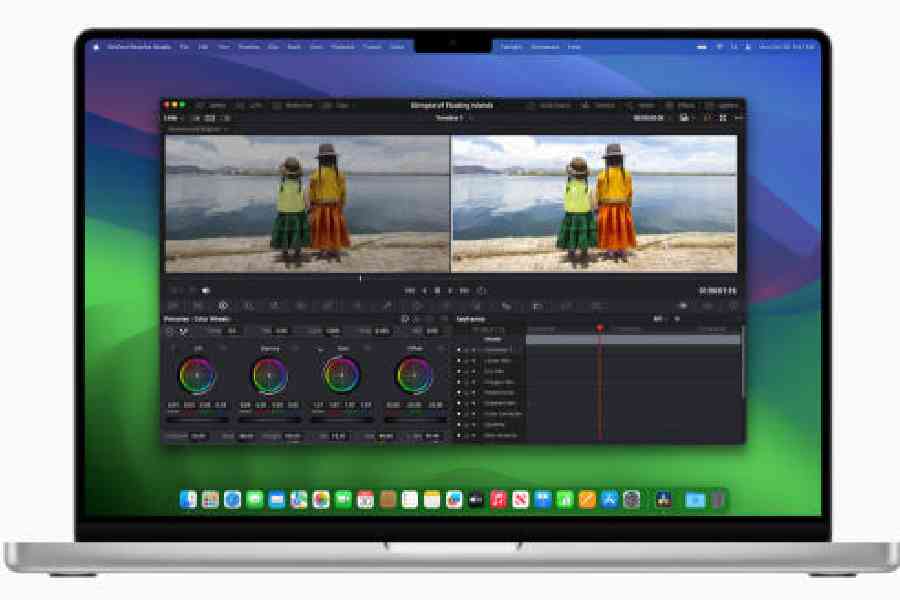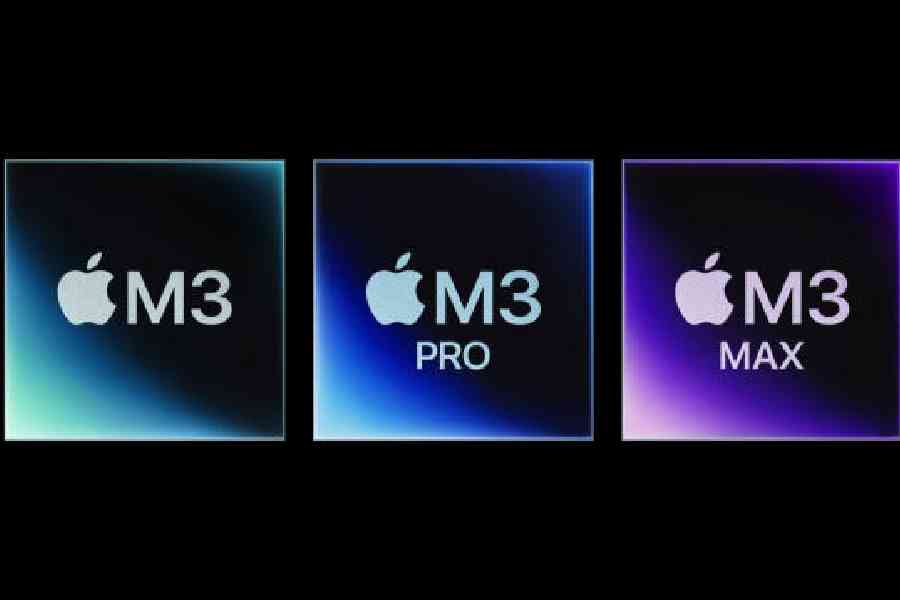The night before Halloween, the Great Pumpkin rose out of the pumpkin patch. He made his way through the maze at Apple Park with the intention of scaring Apple CEO Tim Cook and his men. The 62-year-old was perhaps in an introspective mood, making him greet the Great Pumpkin with a ‘boo’. It was enough to turn him into a cup of pumpkin-spiced latte and what followed is the company’s Scary Fast event, which introduced MacBook Pros and a new iMac. Plus, the new MacBook Pro is a massive upgrade for any user who has not yet upgraded from an Intel-based Mac.
Power-packed punches
Apple found freedom once it started producing its M-series processors in 2020. So far, we have seen the M1 and M2, followed by the high-end versions — the Pro, Max, and Ultra models. This is the first time, the company has announced three tiers of its new chip simultaneously — the M3, M3 Pro, and M3 Max. Sure, the Ultra variant hasn’t been announced but we can expect that in the coming months.

The new iMac with M3 delivers more performance and capabilities to everyone, from families to small businesses to aspiring creatives, along with students and gamers
What makes the new silicon different is that it’s built on a 3-nanometer process technology instead of 5-nanometer, meaning more transistors pack into a smaller space. Further, you get better speed and power efficiency.
There are some new features that distinguish the new Apple silicon and one of the big ones is dynamic caching. It allows the processor to allocate memory for each task dynamically. So the allocation moves up or down as needed rather than cordoning off a set amount of memory for a task, whether it needs it or not. The new approach makes best use of resources.
“With 3-nanometer technology, a next-generation GPU architecture, a higher-performance CPU, faster Neural Engine, and support for even more unified memory, M3, M3 Pro, and M3 Max are the most advanced chips ever built for a personal computer,” said Johny Srouji, Apple’s senior vice-president of hardware technologies.
There is more: ray tracing and mesh shading, which help execute graphics-intensive games and apps. Game developers can utilise ray tracing to offer accurately illustrated lighting elements, such as reflections and shadows. Hardware-accelerated mesh shading assists visually intensive scenes and makes them appear smoother.
Here’s the difference between each version of the next-generation chipsets. M3 has an 8-core CPU, with four performance cores and four efficiency cores that is up to 35 per cent faster than M1 for CPU performance. And it supports up to 24GB of unified memory. Moving on to M3 Pro, the 12-core CPU design has six performance cores and six efficiency cores, offering single-threaded performance that is up to 30 per cent faster than M1 Pro. Actions like manipulating panoramic photos in Adobe Photoshop are faster than ever. And the most powerful at the moment: M3 Max. It has 16-core CPU features 12 performance cores and four efficiency cores, achieving astonishing performance that’s up to 80 per cent faster than M1 Max. And with two ProRes engines, M3 Max makes video post-production work on even the highest-resolution content fast and fluid, whether using DaVinci Resolve, Adobe Premiere Pro, or Final Cut Pro.

With the new MacBook Pro with M3 Max, video post-production work on the highest-resolution content in apps like Blackmagic DaVinci Resolve Studio is a breeze, thanks to two ProRes engines
MacBook Pro (14-Inch and 16-Inch)
A few days ago, I spoke to a Bollywood film director and he mentioned the MacBook Pro several times and how it helps his workflow. After giving a meaningful design update a couple of years ago, Apple has worked on the internals for the new models, besides a couple of changes to the display and coming up with better battery life. Both MacBook Pro sizes now have displays that are 20 per cent brighter. Further, Apple claims up to 22 hours of battery life, depending on the configuration.

MacBook Pro with M3 Pro or M3 Max is available in Space Black
What’s more important is the chipset. You can configure the 14-inch MacBook Pro with an M3 chip or a pro-level model with a base-level chip. When paired with M3, it is up to 60 per cent faster than the 13‑inch MacBook Pro with M1, and with its advanced thermal system, it unleashes the full potential of M3 for sustained performance. The model with M3 comes with two USB-C Thunderbolt 4 ports instead of three. For the extra port, you’ll have to opt for more power and order the 14-inch or 16-inch models with the M3 Pro or the M3 Max chips.
Space Black looks fantastic
M3 Pro and M3 Max powered MacBooks are coming in space black, which makes the laptops look ‘pro’. The finish is the outcome of a process that forms an anodisation seal to reduce fingerprints. The 14‑inch MacBook Pro with M3 is available in silver and space grey.
Goodbye Touch Bar
The new MacBook Pros mean the discontinuation of the last MacBook Pro with Touch Bar, the OLED strip that was both loved and disliked during its long life (at least by tech world standards) — October 27, 2016 to October 30, 2023. The Touch Bar was meant to be a replacement for physical key function and it remained exclusive to the MacBook Pro even though demand for the MacBook Air and Mac desktops increased. The process of killing the Touch Bar started with the redesigning of the MacBook Pro.

The latest M3 series chips from Apple
A new 24-inch iMac
It would have been three years had Apple not gone for a refresh with its iMac. The new colourful line looks the same from the outside. There is a 24-inch, 4.5K Retina display, a 1080p FaceTime camera, a six-speaker sound system and, of course, top-of-line mics. The base model packs two Thunderbolt ports while the high-end models come with two Thunderbolt ports and two additional USB 3 ports (plus support for Gigabit Ethernet).
The update for the all-in-one comes in the form of the M3 chip. The M3 has an eight-core CPU, up to a 10-core GPU, with support for up to 24GB of RAM and 2TB of storage. Apps like Safari and Microsoft Excel will run up to 30 per cent faster. The new chip allows up to 12 streams of 4K video, and Adobe Photoshop should also process photos up to two times faster. It also now supports Wi-Fi 6E. Needless to say, each iMac comes with colour-matched peripherals.
The new offering is designed to minimise its impact on the environment. The new iMac with M3 is built using 100 per cent recycled aluminium in the stand, recycled rare earth magnets, recycled tin soldering in multiple printed circuit boards, and, in a first for iMac, 100 per cent recycled gold in the plating of multiple printed circuit boards. iMac is also free of numerous harmful substances such as beryllium, brominated flame retardants, and mercury, and 100 per cent of the wood fibre in the packaging is recycled or comes from responsibly managed forests.
At a glance
Device: iMac with new M3 chip
Pricing and availability: You can order right away and delivery begins November 7. iMac with 8-core GPU starts at Rs 134,900 and Rs 129,900 for education, and is available in green, pink, blue, and silver. iMac with 10-core GPU starts at Rs 154,900 and Rs 144,900 for education, and is available in green, yellow, orange, pink, purple, blue, and silver.
Device: MacBook Pro
Pricing and availability: You can order right away and delivery begins November 7. The 14-inch MacBook Pro with M3 starts at Rs 169,900 and Rs 158,900 for education; the 14‑inch MacBook Pro with M3 Pro starts at Rs 199,900 and Rs 184,900 for education; and the 16‑inch MacBook Pro starts at Rs 249,900 and Rs 229,900 for education.











